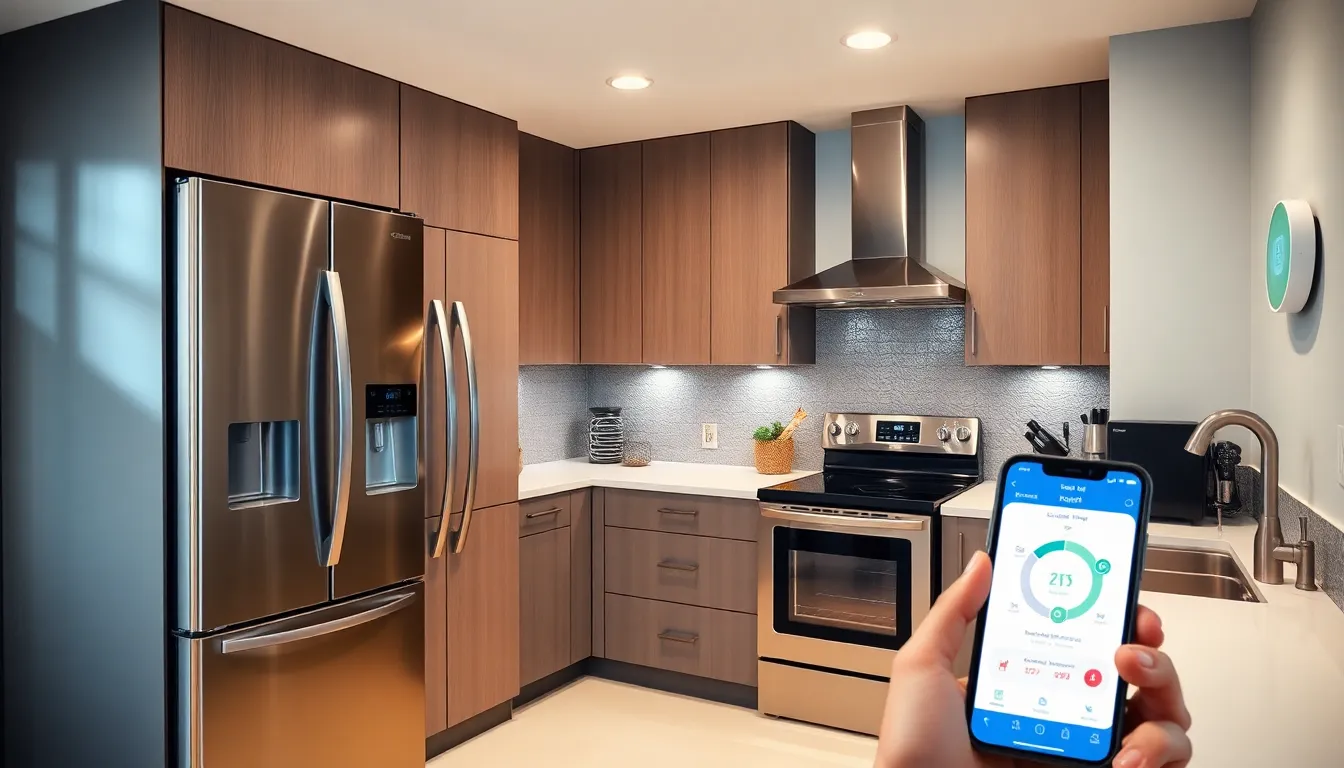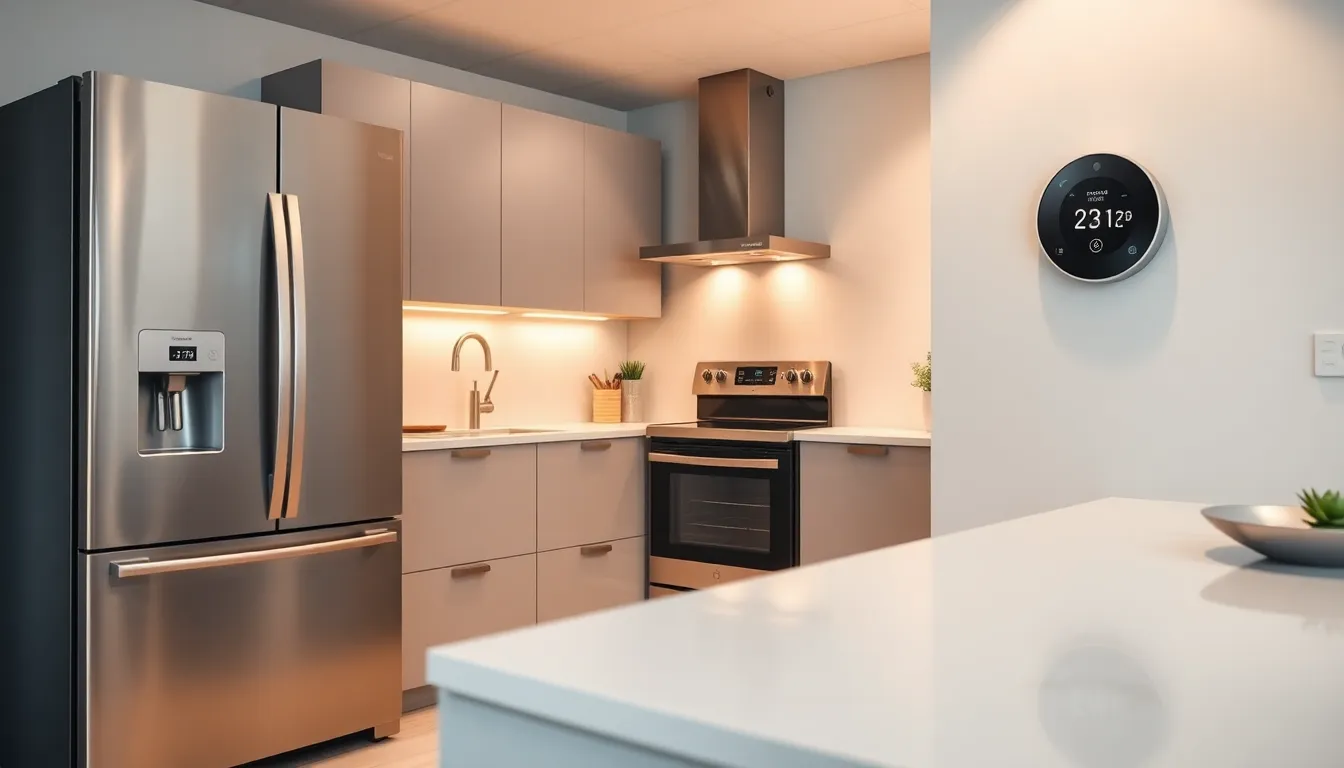In today’s fast-paced world, connected home appliances are transforming the way people live and interact with their homes. These smart devices, equipped with internet connectivity, offer convenience and efficiency like never before. From refrigerators that track groceries to washing machines that can be controlled remotely, these innovations are redefining household management.
As technology advances, the appeal of a fully connected home grows stronger. Homeowners are increasingly embracing the benefits of automation, which not only simplifies daily tasks but also enhances energy efficiency. With a seamless integration of smart gadgets, individuals can enjoy a more streamlined and enjoyable living experience. Exploring the world of connected home appliances reveals a future where comfort and technology work hand in hand.
Table of Contents
ToggleOverview of Connected Home Appliances
Connected home appliances refer to smart devices that integrate with home networks, allowing users to control and monitor them remotely. These appliances streamline household tasks, providing convenience and efficiency through automation. Common categories include smart refrigerators, ovens, washing machines, thermostats, and lighting systems.
Smart refrigerators can track inventory, suggest recipes based on available ingredients, and connect to grocery delivery services. Ovens offer preheating options and cooking reminders, ensuring meals are prepared optimally. Washing machines enable scheduling cycles from smartphones, improving laundry management.
Thermostats enhance energy efficiency by learning occupants’ habits, adjusting temperatures accordingly. Smart lighting systems allow users to control brightness and color, enhancing ambiance from anywhere. Each category contributes to reducing energy usage and minimizing operational costs.
Integration of these appliances with voice assistants expands functionality. Users can issue commands or queries, making daily routines simpler. As technology continues to advance, connected home appliances evolve, promising enhanced comfort and convenience in modern living spaces.
Benefits of Connected Home Appliances

Connected home appliances offer significant advantages, particularly in terms of convenience and energy efficiency. These smart devices not only simplify tasks but also optimize resource usage, contributing to a modern lifestyle.
Improved Convenience
Connected home appliances enhance convenience through automation and remote access. Smart refrigerators manage inventory, suggesting recipes based on available ingredients. Ovens provide users with options for preheating and remote monitoring. Washing machines can be scheduled and controlled via smartphone apps for optimal flexibility. Thermostats learn users’ heating and cooling preferences, adjusting automatically for comfort. Smart lighting systems enable users to control ambiance settings with voice commands or mobile devices. This level of control allows homeowners to manage their environments effortlessly, saving time and improving daily routines.
Energy Efficiency
Connected home appliances contribute to energy efficiency by optimizing usage patterns. Smart thermostats adjust temperatures based on user habits, leading to energy savings of up to 10-15% annually. Smart lighting systems use LED technology and can automatically adjust brightness and color based on natural light levels, reducing electricity consumption. Smart appliances also offer usage reports, allowing users to monitor energy consumption and address inefficiencies. Integrating these devices with renewable energy sources, like solar panels, enhances overall sustainability, promoting eco-friendly practices and reducing utility costs.
Popular Connected Home Appliance Categories
Connected home appliances fall into several popular categories, each offering unique functionalities that enhance convenience and security in households. These appliances integrate with home networks, promoting efficiency and improved living experiences.
Smart Kitchen Devices
Smart kitchen devices revolutionize how individuals manage cooking and meal preparation. Smart refrigerators monitor inventory, track expiration dates, and suggest recipes based on available ingredients. Smart ovens feature remote preheating, precise temperature control, and cooking notifications, ensuring meals are prepared perfectly. Additionally, smart dishwashers offer scheduling, allowing users to run cycles during off-peak energy hours, maximizing efficiency and reducing costs.
Home Security Systems
Home security systems provide peace of mind by enhancing monitoring and control over personal safety. Smart cameras allow users to view live feeds and receive notifications about unusual activity via mobile apps. Smart doorbells feature two-way audio and video capabilities, enabling communication with visitors remotely. Alarm systems can be integrated with smart locks, ensuring secure entry and exit while allowing homeowners to manage access from anywhere.
Smart Climate Control
Smart climate control systems optimize heating and cooling in homes, resulting in improved energy efficiency. Smart thermostats learn user behaviors and adjust temperatures automatically, ensuring comfort while minimizing energy consumption. These devices often integrate with weather forecasts to optimize settings based on external conditions. Additionally, smart air purifiers and humidifiers monitor air quality, adjusting operations to maintain a healthy indoor environment.
Challenges and Concerns
Connected home appliances present various challenges and concerns that consumers must consider. Addressing these issues is crucial to ensure a seamless experience and maintain user trust.
Privacy and Security Risks
Privacy and security risks constitute significant concerns with connected home appliances. These devices collect vast amounts of personal data, including usage habits and household routines. Cyberattacks pose threats as hackers may exploit vulnerabilities in the appliance’s software. If compromised, these devices can provide unauthorized access to personal information and even control over household systems. Implementing robust security measures, such as regular software updates and strong passwords, can mitigate these risks, but homeowners must remain vigilant.
Compatibility Issues
Compatibility issues frequently arise as various brands and devices may not integrate seamlessly. Different manufacturers often use proprietary protocols, preventing effective communication between appliances. This incompatibility can limit the full potential of a connected home ecosystem. Homeowners may face challenges when adding new devices, requiring careful selection to ensure smooth interactions. Choosing devices that adhere to common standards, such as Wi-Fi or Zigbee, can enhance interoperability and streamline the integration of connected home appliances.
Future Trends in Connected Home Appliances
Connected home appliances are evolving rapidly, driven by advancements in artificial intelligence (AI), the Internet of Things (IoT), and data analytics. Expect significant shifts in functionality, usability, and integration.
- Increased Interoperability: Connected home appliances will demonstrate improved compatibility across various platforms. Open standards and protocols will enable seamless communication between devices from different manufacturers. Harmonized ecosystems enhance user experience and expand automation possibilities.
- Enhanced AI Capabilities: AI integration will lead to smarter appliances that learn user preferences and adapt accordingly. For example, smart refrigerators may analyze shopping habits to generate personalized grocery lists, while washing machines can adjust settings based on fabric types. AI will streamline energy management and facilitate proactive maintenance alerts.
- Voice and Gesture Control Expansion: Voice-activated technology will become ubiquitous in connected home appliances. Devices will incorporate advanced voice recognition and gesture control for more intuitive interaction. Users may initiate tasks or adjust settings through natural language or simple hand movements, making technology more accessible.
- Focus on Sustainability: Eco-friendly features will gain traction as consumers prioritize sustainability. Connected home appliances will optimize energy consumption based on real-time data, contributing to lower carbon footprints. Manufacturers will design products that integrate with renewable energy sources, encouraging an environmentally conscious living space.
- Improved Security Protocols: As concerns about privacy and data security rise, connected home appliances will incorporate stronger encryption and privacy measures. Users will have greater control over data sharing options, ensuring that personal information remains secure. Manufacturers will prioritize transparency regarding data usage and device security.
- Health Monitoring Features: Connected appliances will increasingly incorporate health and wellness monitoring. For example, smart refrigerators may track dietary habits, while air quality monitors will monitor indoor air pollutants. These features promote healthier living environments, aligning with growing consumer awareness of health impacts.
- Customized User Experiences: Personalization will become a key focus, with devices offering tailored experiences based on individual needs or lifestyles. Smart lighting systems could adjust brightness and color according to time of day or activities. This level of customization enhances user comfort and satisfaction.
These trends indicate a future where connected home appliances contribute significantly to everyday living, enhancing convenience, efficiency, and overall quality of life.
Connected home appliances are revolutionizing the way people manage their households. They offer unmatched convenience and efficiency, making daily tasks simpler and more enjoyable. As technology continues to advance, these devices will become even more integral to modern living, providing seamless integration and enhanced functionality.
While challenges like privacy and compatibility remain, the benefits far outweigh the drawbacks. Homeowners can look forward to a future where smart appliances not only save time and energy but also promote a more sustainable lifestyle. Embracing this technological shift will undoubtedly lead to a more connected and comfortable home environment.



